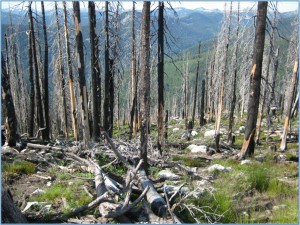2011 Re-measure WBP Permanent Plots in Burns
Project: Re-measure WBP Perm Plots in Burns
Agency/Forest or Park/District: Selkirk Mountains, Idaho Panhandle National Forest
Project coordinator: Pat Behrens
Contact: Pat Behrens – USFS. 6286 Main St. Bonners Ferry ID, 83805. 208-267-6743 pbehrens@fs.fed.us
Cooperators
USDA Forest Service Forest Health Protection
Source of funding /amount
FHP: $16,000
Supplemental funding: $11,500 NFVW (NFRR)
Dates of restoration efforts
July-September 2011
Objectives
Monitor the success of natural whitebark pine regeneration in prescribed burn treatments. The Selkirk WBP Restoration Project was initiated in October 2006 using prescribed fire and slashing on over 1300 acres. Permanent whitebark pine monitoring plots were established on the Ball Lakes, Russell Peak, Fisher Ridge and Farnham Ridge in August 2007. Thirty plots on each treatment area (10 plots in the “no burn”, 10 plots in the “moderate burn” and 10 plots in the “severe burn.” 120 plots total were established. First year post-treatment surveys were conducted concurrent with plot installation, which was too soon to detect any WBP regeneration.
Acres/ha treated
1300 acres
Methods
5th year measurement of 120 permanent plots
Planting? If so, source of seedlings? Resistance? No
Outcome
There was no evidence of any new germinates during this monitoring cycle. All of the whitebark observed in was established prior to the 2007 Rx burn.
Monitoring since completion of the project
Dates: 2011 was the first year plots were monitored
Plans for future monitoring? Monitoring is scheduled every five years
Will outcome meet goals?
Currently, it is too early to tell whether the restoration goals will be met. There still appears to be adequate mature whitebark pine seed source available to support natural regeneration.
Future actions/follow up?
Planting may ultimately be necessary for restoration of the species.
Miscellaneous comments
Planting
If planting is ultimately deemed necessary to achieve restoration objectives in the Selkirks it will certainly require significant partnership dollars In addition to anticipated high seedling costs there are the logistical concerns of physically getting seedlings to the site. The area is mostly inaccessible from roads, open, or closed. If helicopters, or opening closed roads, are considered for delivering seedlings consideration must be given that the majority of the planting sites are located in grizzly bear core habitat, which would require consultation with the USFWS. These issues are not insurmountable, but they must be given detailed consideration in the planning process.
WBP Verbenone Overview (June 27, 2007)
On April 20, 2007 a helicopter survey was conducted of the treatment areas to estimate the amount of live WBP. A summary of the data collected is listed in the table below.
| Area | # of live WBP treated | Comments |
| Burton Ridge | 125 | Each was GPS’d |
| Russell Ridge | 110 | Beetle activity noticed |
| Ball Lake | 101 | Beetle activity noticed |
| Farnham Ridge | 10 | Beetle activity noticed all GPS’d |
| Fisher Peak | 45 | Each was GPS’d |
| Cut-Off | 400+ | @ 20 packets per acre installed |



